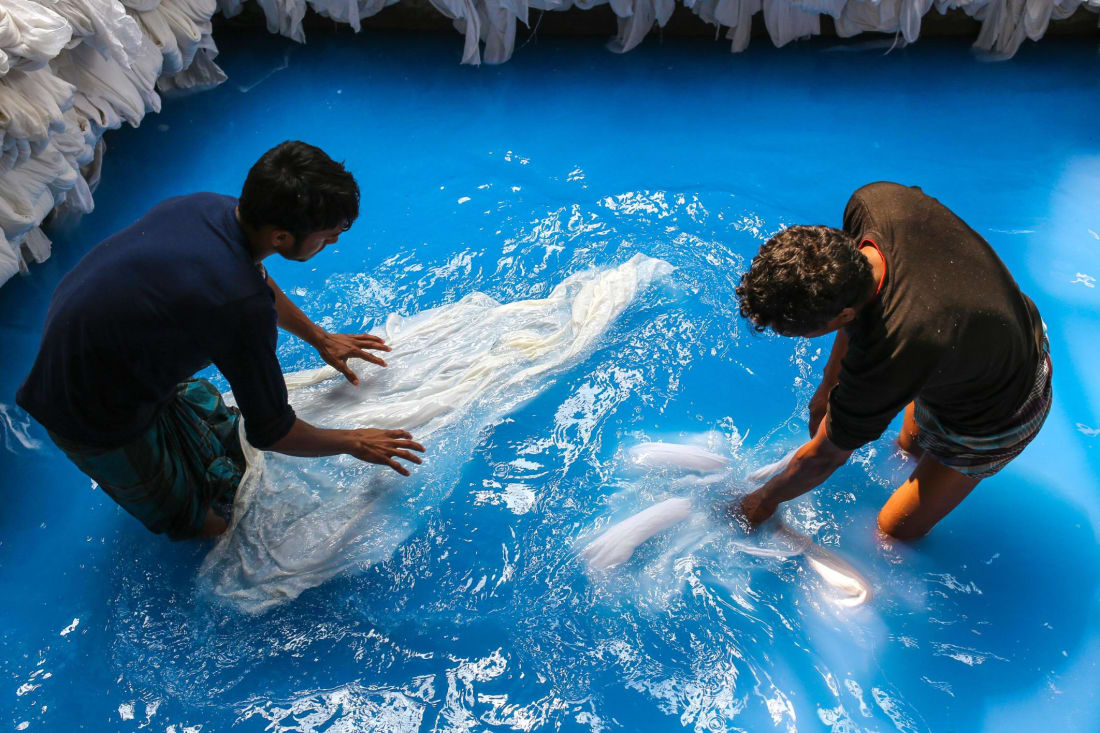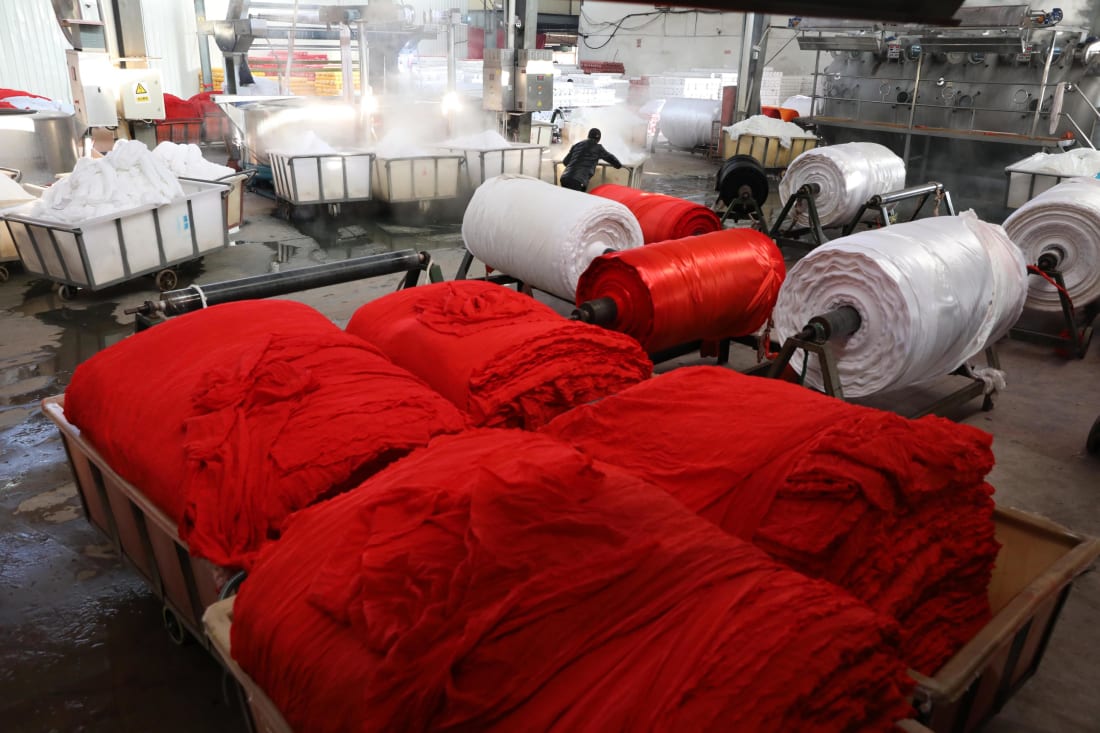If you’re anything like me, your closet is full of bright colors and whimsy patterns. Or maybe you’re drawn to the classics, you can never go wrong with blacks and whites. But these colorful textiles come at a price. Bright yellows and reds are often produced by synthetic “azo” dyes, nitrogen based synthetic compounds frequently used in food, pharmaceutical, leather, and of course, textiles. However, many of these dyes are carcinogenic and dangerous to the environment.
How dangerous can a little color be? More than you might think. For years, the textile industry has been using azo dyes and pouring toxic waste into our oceans and lakes, contributing to 20% of the world’s industrial water pollution.
How exactly are azo dyes harmful to our health?

Workers in dyeing factory. (source: CNN)
Everyday, we are exposed to azo dyes, whether it be through our colorful closets or the food we eat. Although azo dyes are inexpensive and create bright colors, these dyes can also trigger skin allergies, sores, gastrointestinal issues, and increase risks of cancer. These health hazards are not new discoveries. As early as 1895, studies showed that workers in dye manufacturing had higher rates of bladder cancer. More recently, a study in Brazil found azo dye pollution as a cause of cancer in a river serving as a common drinking source for around 60,000 people.
So how are Starbursts, and other colorful foods, safe to eat? They might not be. The FDA claims that the amount of azo in our foods and clothes are so low they don’t pose a threat to our health. On the other hand, the EU has banned many of these dyes due to their carcinogenic properties and have begun coloring their candies with natural pigments, such as carotene.
To best understand how our seemingly innocuous wardrobe is the culprit of so many health and environmental issues, we will start at garment dyeing plants to understand how our clothes and colors are produced.
What happens in dyeing mills?

Fabric dye factory in Hangzhou, China. (source: CNN)
Although most fashion consumption occurs in Western countries, like the US, most dyeing mills are located in developing countries, specifically in far-east Asia. Things haven’t always been this way.
Since realizing the adverse effects of dye pollution, companies have relocated manufacturing from the US to developing countries with lax law enforcement and cheap labor. In Bangladesh, dye wastewater is dumped directly into nearby lakes, exposing these communities to health hazards and degrading the environment.
The dyeing and finishing process is also especially water intensive. Water is used in each step: preparation, dyeing, finishing, and rinse.
Preparation
The fabric is first prepared by removing any impurities through a wash and additions of hydrogen peroxide, enzymes, or brightening agents.
Dye
There is no one-size fits all when it comes to the type of dye used for different textiles. However, the process often includes using synthetic ingredients, usually azo dyes. Popularized in the 1880s, azo dyes are vibrant dyes that color half of textiles globally because they are cheap and bright. However, azo dyes can be carcinogenic and endocrine disruptors, meaning they can result in cancer, birth defects, and other developmental disorders” These dyes also do not decompose and can accumulate in the bodies of water they are dumped in.
Finishing
During the finishing process, garments are chemically treated to improve fabric quality, undergoing treatments like permanent press, microbial/fungus protection, and softening. During this process, the fabrics are heated and steamed to retain this chemical application, and are rinsed thoroughly.
How are azo dyes harmful to the environment?

Man walks through dye-polluted rainwater in Shyampur, Bangladesh. (Source: CNN)
Once the dye process is finished, the hundreds of gallons of water used to rinse the garments are usually dumped into a nearby stream, despite being loaded with all the toxic chemicals during the process. The untreated discharge contributes to 80% of the total emissions produced by the textile industry.
The World Bank has identified 72 toxic chemicals expelled in waterways as hazardous to public health. The rivers that run through Dhaka, Bangladesh are now a “pitch black color” and elicit toxic smells due to the pollution from nearby mills. .These chemicals build up in skin and increase risk to cancer and other ailments. In many developing countries, the same river water is used for crop irrigation and contaminates produce, further exposing people to these chemicals. Moreover, the mill workers often inhale, ingest, and are exposed to harsh chemicals, as there is inadequate protective clothing.
This discharge negatively affects lake ecosystem biodiversity and soil health because it increases temperature and pH levels. Dark dyes clock sunlight, inhibiting photosynthesis, and leading to a decrease in oxygen which affects all life in these lakes. The toxicity of the sludge is extremely harmful to aquatic animals, causing growth reduction, neurosensory damage, metabolic stress, and even death in fish.
What efforts are being taken to mitigate these harms?
In regards to the health and environmental hazards of azo dyes, many countries, such as those in the EU, have banned these carcinogenic substances. However, many dye manufacturing plants, commissioned by multinational retailers, are located in developing countries, like Bangladesh, where azo dyes are still permitted. This allows companies to use these cheap dyes and save on production costs, while compromising the health and environment of these communities.
Different organizations and manufacturers have begun to look at alternatives to dye processing and treatment, including using organic, plant-based dyes and materials that can benefit health and the environment. However, these are more time-intensive, expensive, and require even more water usage. The EPA also launched a coalition called “The Sustainable Apparel Coalition” that aims to investigate sustainable strategies for the garment industry in over 35 countries. Governments have also implemented stricter disposal regulations and are setting up water treatment plans. Despite new technologies and alternative dyes, there still needs a systematic change in the industry that focuses on less water consumption and pollution, while maintaining public and environmental health.
While we wait for any increment of top-down change, we as consumers can leverage our dollar by investing in companies who have socially and environmentally conscious practices.




















